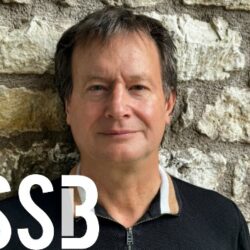A Geographical Approach for Collaboration and Connection?
In the first two blogs (see series description at bottom) I explored the links from psychogeography through to other disciplines, including both the social sciences and the arts. The third article showed how digital innovations emerged during the pandemic, such as making a virtue of being social-distanced to walk using techniques such as the #distancedrift. In this final piece I show how groups of people harnessed psychogeography through digital technologies in 2021 and 2022, potentially opening team projects across different places. Throughout this writing I identify some common themes and look towards some practical applications within social sciences.
Connecting with likeminded people
Like many branches of research and study, it can be difficult to find people living nearby who share the same passion. Moreover, movements lose their momentum or change into different forms. In the last blog I explored how the Forth World Congress of Psychogeography (4WCOP) – which started in Huddersfield in west Yorkshire, UK – embraced the pandemic in 2020 by staging a three-day programme of online activities.
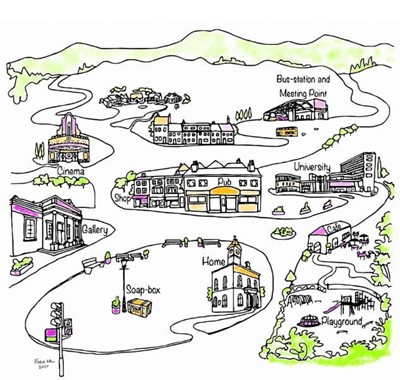
Meeting people from across really opened up the possibility of learning together. One result was a group of people, including me, forming the ‘Winter Theory School.’ This would allow the conversation to continue over the dark months on the pandemic. We held an online gathering every other Tuesday evening for people across Europe to share ideas and short photo essays. We also took ourselves to other places by watching films: Wim Wenders’ depiction of cold-war Berlin in Wings of Desire was particularly interesting. At the end of this blog, I reflect on members of the group meeting in person and developing some interesting new practice. In the meantime, I present some of the psychogeographical adventures from Saturday and Sunday, September 4 and 5, at the 2021 World Congress.
Saturday programmes spans time zones
The Congress started at 9:30 a.m. BST and included a packed programme of talks and online workshops through to the early evening. As the sun started to set in Britain we were invited to join Babak Fakhamzadeh’s immersive WalkRoulette. Babak created this a platform for participants to discover an online urban environment where they can also communicate with each other. The graphics were quite blocky (see below) and certain functions were available only at certain points for players to tell Babak which direction to go in. In reality he was actually running around an unknown city in Argentina with us as his guides. At the time it seemed quite surreal, but there could be some longer-term applications. For example, this online world could be used to guide others during an emergency within large buildings or sites such as parks.
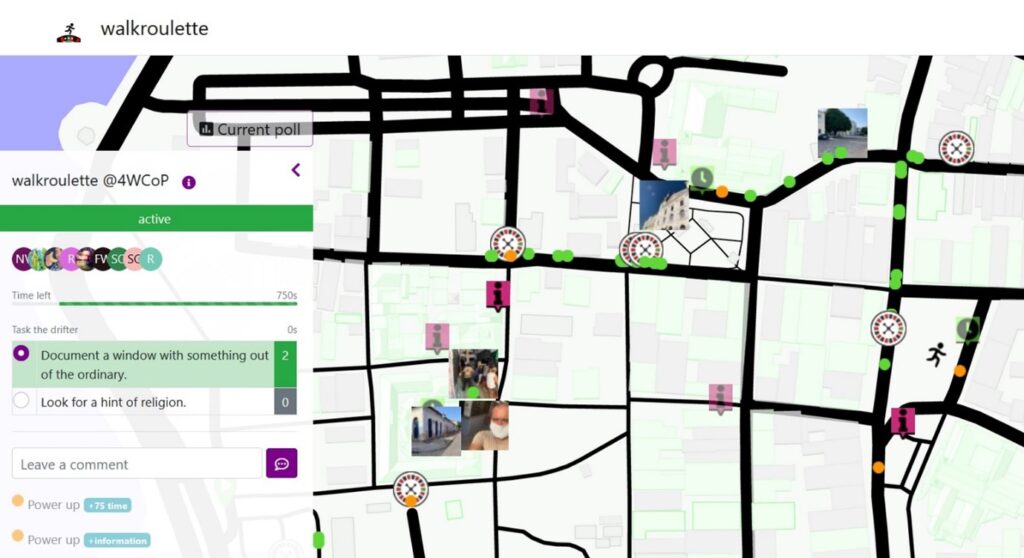
Not long after Babak’s high-energy experience we met Cadu Cinelli, who is from Brazil, and has used his bike to travel around and meet people. In an interview he explained his desire to meet ‘…people who are not in the mainstream of cities, but those who work backstage – bricklayers, cleaners, drivers, mothers, grandmas, children and workers.’ There is a mesmerizing video made from a Zoom broadcast. In the main screen we see a film of the places through which Cadu cycled. Simultaneously he adds poetry and music and invites questions. Cadu is a fan of psychogeography as it helps ‘…reconnect to your own body, your breath, feel around you, where you are, the sensations of being alive exactly in the place we must be.’ His approach is very creative, but also explicitly about being vulnerable and engaging with sensations, emotions, feelings, perceptions, and memories. There is a lot that his talk revealed about the politics in Brazil in 2021. Personally, I would love to see an ethics committee approve a piece of research which is carried out on a bike and presented in such a poetic way. Cadu also likes to create embroidery from his adventures.
What I learned from these two examples was how far people take the idea of following a line to meet people and explore the world. I also value the way in which Zoom was used in Cadu’s case to make a new film from a range of sources. That Saturday night finished in Europe with a ‘pocket disco’ where people danced simultaneously (together and alone) in multiple locations. At one point I found that the lights dimmed were in my kitchen in Wales and I was sharing a virtual dancefloor as it was still daytime in Brooklyn and locations in South America. The next example returns to the UK and follow’s some of the political openings crated by Cadu.
First Sunday Walks
The LRM (Loiterers Resistance Movement) is a Manchester based collective of artists, activists and urban wanderers interested in psychogeography, public space and the hidden stories of the city. Since being started by Morag Rose in 2006, they have been committed to making psychogeography as accessible and engaging as possible. They describe themselves as ‘join[ing] the dots between people and place, creating critical conversations and good mischief.’ During the pandemic the LRM went online so people could continue wandering ‘together, alone’ – which is a similar theme to Babak’s work. Morag used a WhatsApp group to share instructions with people interested in walking along remotely.
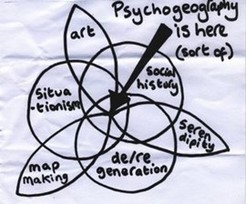
The image at right explains the links to disciplines such as situationism and art, which we have already considered in these blogs. The reference to ‘de/regeneration’ perhaps links back to places like Paris in the 1950s and 1960s-era of the Situationists or Brazil in 2021: how to question the changes proposed for our towns and cities. The LRM continue to argue the case for people who are disabled or primarily access places on foot. Cases in Manchester show how developers continue to look at their own piece of land in isolation, rather than sensing how it may join up with other walking routes.
Some excellent work on access, well-being and creativity was done through 2021 and 2022 by Morag and the wider Walking Publics / Walking Arts team working in Scotland, England and Ireland. The resources include a ‘walking cookbook’ with different idea to get people outside. Although there are some great new ways of using the internet, nothing really beats walking the streets. As this blog draws to a close, I reveal something of my own motivation for taking an interest in psychogeography.
Finding our own flavor
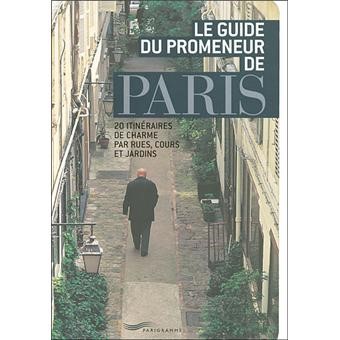
There are still strong links to psychogeography in France. For example, Le Guide du Promeneur de Paris (published in 2007 and shown here) helps the walker to understand how and why the city evolved in the way that it did. In November 2021 my cousin and I visited an urban reservoir, found out why Paris only has two churches with graveyards, and walked through parks created within the openings from stone quarrying. As somebody who has worked in ‘urban regeneration’ – known as ‘urban renewal’ or ‘urban redevelopment’ in other countries – I value sensing how elements of the past are always available to us in the present. By following a line, even if it may seem a strange one, we give ourselves different ways to sense the bigger picture.
A similar theme emerged when I met other members of the Winter Theory School, who I had never met in person before, in Huddersfield during summer of 2022. In one example, London-based digital artist David Upton used a mobile phone app called Echoes to connect stories and sounds with specific places. He created a trail which highlighted spaces between buildings (yards) which had existed for hundreds of years in the town. A sound recording was triggered by walking into that space. Going around the town, searching out yards, I could sense how these spaces had been a kind of operating system which had powered the town for many years. For example, the yards places where people kept their horses, locations to trade or where barrels of beers were unloaded into taverns.
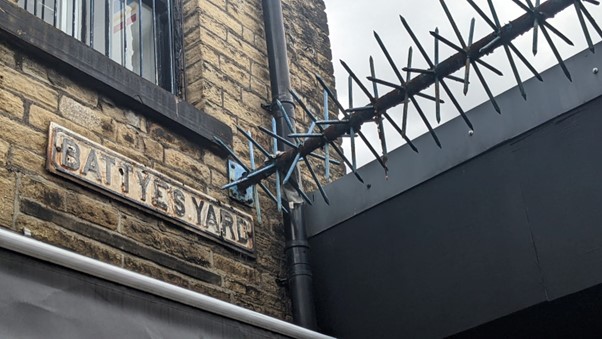
Above – Battye’s Hard. Huddersfield © Aled Singleton, 2022
Through the 20th century, the operating system largely got updated; some yards were covered within shopping centres, some disappeared altogether, and some become car parks. However, some remain as they always were – such as Battye’s Yard – as relatively unloved rear access to buildings which have stood there for a long time. It is hard to predict what will happen now that towns are losing their big shops. However, I will keep on exploring and hope you will also find some inspiration from psychogeography to re-imagine the world.
The series
Mapping the Ebb and Flow of Psychogeography | Broadly speaking we can assume that psychogeography lies between that which studies the psyche and the mind and that which focuses on space and place. However, it is worth stressing that we are mostly concerned with an innovation within geography, particularly of the humanistic kind, rather than a branch of psychology
How British Literary Psychogeography Offers Possibilities for Researchers | Here we explore how the basic principles of Situational International re-emerged as a new form of psychogeography in the British Isles. This form would be less political than the work of Debord, at least on the surface, and would be championed by poets, writers of historical fiction and other forms of literature.
Psychogeography Becomes More Accessible — and Goes Online | Here Aled Singleton explains how practices such as the dérive have been simplified and used by a wide variety of people. Moreover, the lockdown(s) of 2020 encouraged people to think differently about how to use technologies.






